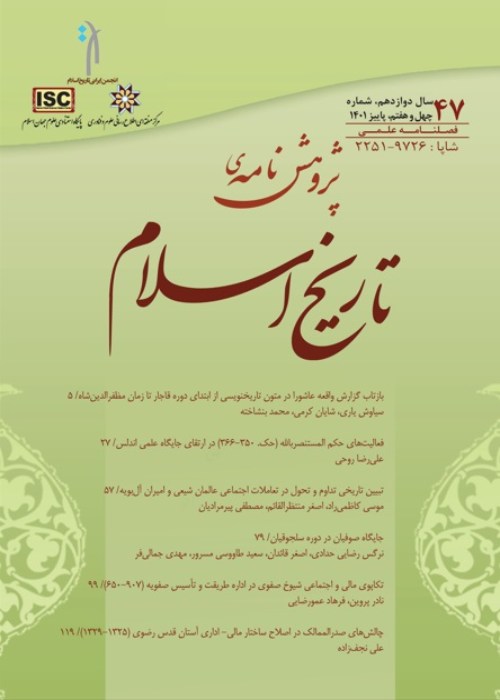Hejaz Music during the Omavid Era
Author(s):
Abstract:
Art with all its branches including painting, illumination, portrait painting, music and architecture are among lasting aspects of Islamic culture and civilization. Islamic art is highly integrated with transcendence and Islamic understanding; in a way that mosque as the main religious centre for Muslims is also called gallery of Islamic arts. This indicates the high status and elevated position of art among Muslim believers and religious scholars. Among other branches of art, music is quite important from several aspects; in a way that we can consider this amusing and attracting branch of art as mankinds twin. Of course, Islam has defined music within particular frameworks and religious scholars and Muslim jurists have held certain perspectives with regard to it, which are beyond the scope of this study. However, there have always been songwriters, musicians, and singers in Islamic societies whothrough acting in contradiction to the ideas of strict juristshave amused their listeners with their charming music; in a way that, during the first Islamic century, music grew and developed tremendously in Mecca and Medina and made these two schools surpass the rivals. The main question investigated in this study is what factor or factors contributed to the tremendous growth of music in Mecca and Medina in less than a century. The assumption is that there were policies adopted by the Omavidsparticularly Moaviyehto make people engaged with luxury and pleasure and separate them from jihad and fighting with corruption and oppression. In this vein, they capitalized on spreading and encouraging various non-political affairs like poetry reading, singing and music among people of Mecca and Medina. Furthermore, the battle of Karbala, Horreh event and capture of holy Mecca are assumed to be among the main factors in making people attracted to charming music and songs played by musicians. The present study, through focusing on this issue, attempts to recognize the outstanding Mecca and Medina music figures.
Language:
Persian
Published:
Quartely Research Journal of Islamic History, Volume:3 Issue: 9, 2013
Pages:
135 to 151
magiran.com/p1620103
دانلود و مطالعه متن این مقاله با یکی از روشهای زیر امکان پذیر است:
اشتراک شخصی
با عضویت و پرداخت آنلاین حق اشتراک یکساله به مبلغ 1,390,000ريال میتوانید 70 عنوان مطلب دانلود کنید!
اشتراک سازمانی
به کتابخانه دانشگاه یا محل کار خود پیشنهاد کنید تا اشتراک سازمانی این پایگاه را برای دسترسی نامحدود همه کاربران به متن مطالب تهیه نمایند!
توجه!
- حق عضویت دریافتی صرف حمایت از نشریات عضو و نگهداری، تکمیل و توسعه مگیران میشود.
- پرداخت حق اشتراک و دانلود مقالات اجازه بازنشر آن در سایر رسانههای چاپی و دیجیتال را به کاربر نمیدهد.
In order to view content subscription is required
Personal subscription
Subscribe magiran.com for 70 € euros via PayPal and download 70 articles during a year.
Organization subscription
Please contact us to subscribe your university or library for unlimited access!


